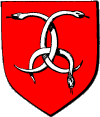Serpent
Serpent


Serpent: the serpent or snake, for they are in heraldry absolutely synonymous, (fr. serpent), is found in the ancient rolls under the name of bis; the word survives in the Italian biscia, or cobra of Milan. The reptile occurs rather frequently in coats of arms, and its position should be described. As seen in the case of the arms of CAIUS above, it may be represented erect. It may also be drawn gliding or fessways.
It may be involved or encircled(both terms meaning the same), as shewn in the margin, in which position it occurs in the arms of WHITBY Abbey. The device was probably suggested by the fossil Ammonites, found in the lias clay there, and which were at first supposed to be petrified snakes. When involved, the French heralds seem to use the word guivre for snake.
Le Counte de TRERSTEYN, dor a un byse de goules--Roll, temp. HEN. III.
Monsire William MALBIS, d'argent a une cheveron de gules a trois testes de bys rases gules--Roll, temp. ED. III.
Argent, a chevron gules between three serpents erect proper--COTTER, Bart, 1763.
Argent, two serpents erect endorsed--LONGSHARE.
Or, three serpents erect wavy sable--CODLEW, or CUDLEW.
Argent, three serpents gliding in pale azure--DUCAT.
Argent, two bars gules; over all as many serpents erect, respecting each other, vert--REFUGE.
Argent, a serpent involved vert--O'DRONE, Ireland. [Another family, three snakes involved vert.]
Argent, three serpents voluted--DIGON, or TROGONE, Ireland.
Azure, three serpents encircled or; two and two--WHITBY Abbey.
D'argent à la guivre d'azur, tortillante en pal, [generally blazoned 'couronnée d'or,'] 'engloutissante un enfant' issante de gueules--Duché. de MILAN.


Snakes are also represented nowed, (q.v.), or twisted in a knot. In the crest of CAVENDISH the reptile is represented as in the margin, and theoretical heralds contend that if represented as in the lowest of the two figures it would be nowed reversed. Also, as will be seen, there are complications of the nowed position.
One or two other varieties are given, but heraldic writers such as Holme devote several pages to imaginary positions of serpents, and fanciful terms to fit them, none of which, however, are found to occur in any coats of arms. They are sometimes represented with tails in their mouths; at others round a pillar, or round necks of children. (See arms of VAUGHAN under Enveloped.)
See also Adder, from which there is little or nothing to distinguish the charge in heraldic drawing.

Argent, two serpents nowed and linked together in pale between two stars gules--ARWELL, Scotland.
Gules, three snakes nowed in triangle argent--EDNOWAIN AP BRADWEN, Merionethshire.
Gules, three snakes nowed in triangle argent, within a bordure engrailed or--LEWIS, Warwickshire.
Vert, a serpent bowed embowed debruised, the head erect, the tail torqued or--BLOORE.
Azure, three serpents, each encircled, their tails in their mouths argent[in French blazon, 'D'azur, a trois serpents d'argent arrondis se mordant la queue, posées 2 et 1']--DE LAUZON, Poitou.
Azure, a bend or in chief three boy's heads couped at the shoulders argent, each enwrapped about the neck with a snake proper; in base as many griffin's heads erased of the third--MADOCK, co. Gloucester.
Gules, a stellion[?] serpent proper--BUME.
Please Help!
DrawShield is a Free service supported by its users.

If you can, please help cover the cost of the server, or just buy the team a coffee to say thanks!
 Buy me a coffee
Buy me a coffee


